-
Be the first to like this
-
The AI Rush by Jean-Baptiste Dumont 1113480 views
-
AI and Machine Learning Demystified... by Carol Smith 3639736 views
-
10 facts about jobs in the future by Pew Research Cent... 671497 views
-
2017 holiday survey: An annual anal... by Deloitte United S... 1085446 views
-
Harry Surden - Artificial Intellige... by Harry Surden 633592 views
-
Inside Google's Numbers in 2017 by Rand Fishkin 1215637 views
EPA CompTox chemicals dashboard: An online resource for environmental chemists
Published on
The U.S. Environmental Protection Agency (EPA) Computational Toxicology Program integrates advances in biology, chemistry, and computer science to help prioritize chemicals for further research based on potential human health risks. This work involves computational and data driven approaches that integrate chemistry, exposure and biological data. As an outcome of these efforts the National Center for Computational Toxicology (NCCT) has measured, assembled and delivered an enormous quantity and diversity of data for the environmental sciences including high-throughput in vitro screening data, in vivo and functional use data, exposure models and chemical databases with associated properties. A series of software applications and databases have been produced over the past decade to deliver these data. Recent work has focused on the development of a new architecture that assembles the resources into a single platform. With a focus on delivering access to Open Data streams, web service integration accessibility and a user-friendly web application the CompTox Chemicals Dashboard provides access to data associated with ~720,000 chemical substances. These data include research data in the form of bioassay screening data associated with the ToxCast program, experimental and predicted physicochemical properties, product and functional use information and related data of value to environmental scientists. This presentation will provide an overview of the CompTox Chemicals Dashboard and its value to the community as an informational hub. This abstract does not necessarily represent the views or policies of the U.S. Environmental Protection Agency.
EPA CompTox chemicals dashboard: An online resource for environmental chemists
- 1. EPA CompTox chemicals dashboard: An online resource for environmental chemists Antony Williams, Chris Grulke, Jeremy Dunne and Jeff Edwards National Center for Computational Toxicology, U.S. Environmental Protection Agency, RTP, NC Spring 2019 ACS Spring Meeting, Orlando http://www.orcid.org/0000-0002-2668-4821 The views expressed in this presentation are those of the author and do not necessarily reflect the views or policies of the U.S. EPA
- 2. CompTox Portal 1
- 3. CompTox Chemicals Dashboard • A publicly accessible website delivering access: – ~875,000 chemicals with related property data – Experimental and predicted physicochemical property data – Experimental Human and Ecological hazard data – Integration to “biological assay data” for 1000s of chemicals – Information regarding consumer products containing chemicals – Links to other agency websites and public data resources – “Literature” searches for chemicals using public resources – “Batch searching” for thousands of chemicals – Real time prediction of physchem and toxicity endpoints 2
- 4. CompTox Chemicals Dashboard https://comptox.epa.gov/dashboard 3 875k Chemical Substances
- 5. BASIC Search 4
- 6. Detailed Chemical Pages 5
- 7. THE POWER OF BATCH SEARCHING 6
- 8. Batch Access to Underlying Data https://comptox.epa.gov/dashboard/dsstoxdb/batch_search 7
- 9. Inputs 8
- 10. CAS Numbers… 9
- 11. Display Chemicals 10
- 12. CAS Numbers… 11
- 13. Possible Outputs… 12
- 14. 13
- 15. “MS-Ready Structures” https://doi.org/10.1186/s13321-018-0299-2 14
- 16. MS-Ready SMILES 15
- 17. Possible Outputs… 16
- 18. TEST and OPERA Predictions 17
- 19. Transparency for prediction models 18
- 20. TEST Real-Time Predictions 19
- 21. TEST Real-Time Predictions with detailed calculation reports 20
- 22. TEST Real-Time Predictions with detailed calculation reports 21
- 23. TEST/OPERA Batch Download 22
- 24. Possible Outputs… 23
- 25. Curation Level Details • We have full time curators checking data 24
- 26. Possible Outputs… 25
- 27. Hazard Data from “ToxVal_DB” • ToxVal Database contains following data: –30,050 chemicals –772,721 toxicity values –29 sources of data –21,507 sub-sources –4585 journals cited –69,833 literature citations 26
- 28. Access to Chemical Hazard Data 27
- 29. Possible Outputs… 28
- 30. In Vitro Bioassay Screening ToxCast and Tox21 29
- 31. Possible Outputs… 30
- 32. Sources of Exposure to Chemicals 31
- 33. Possible Outputs… 32
- 34. IRIS Report 33
- 35. Integrated Data in Excel Sheet 34
- 36. Possible Outputs… 35
- 37. Literature Searching 36
- 38. Literature Searching 37
- 39. Literature Searching 38
- 40. Abstract Sifter for Excel 39
- 41. Possible Outputs… 40
- 42. Identifiers to Support Searches 41
- 43. Possible Outputs… 42
- 44. Transformation Products 43
- 45. Related Substance Relationships
- 46. CASRN Checking 45
- 47. Batch Searching Formula/Mass 46
- 48. Searching batches using MS-Ready Formula (or mass) searching 47
- 49. AN EXAMPLE APPLICATION 48
- 50. Aggregate data for a list of chemicals 49
- 51. Batch Search Names 50 Excel Download
- 52. Add Other Data of Interest 51
- 53. Possible Outputs – Chemical Lists 52
- 54. Batch Search in specific lists 53
- 55. Conclusion • Dashboard access to data for ~875,000 chemicals • Batch search capability for integrated search for thousands of chemicals across diverse data 54 • Future capabilities will include batch prediction • Ongoing data expansion continues day to day • We are committed to open API development for data access and predictions
- 56. Acknowledgements EPA-RTP • An enormous team of contributors from NCCT, especially the IT software development team • Our curation team for their care and focus on data quality • Multiple centers and laboratories across the EPA • Many public domain databases and open data contributors
- 57. Contact Antony Williams NCCT, US EPA Office of Research and Development, Williams.Antony@epa.gov ORCID: https://orcid.org/0000-0002-2668-4821 56 https://doi.org/10.1186/s13321-017-0247-6







Be the first to comment